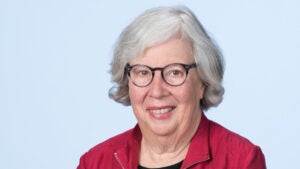
Nobel Prize for AI breakthrough has roots in USC Dornsife professor’s work
Helen Berman, professor (research) of quantitative and computational biology at the USC Dornsife College of Letters, Arts and Sciences, was acknowledged by 2024 Nobel Prize in chemistry laureate John Jumper during a press conference following the announcement of his prize this week.
Jumper highlighted Berman’s pioneering work developing the Protein Data Bank (PDB), which was established in 1971 as the first open-access digital repository for 3D structures of biological molecules.
“I also want to really thank the giants on whose shoulders we stand, I think the entire experimental community, the people that developed the ability to measure protein structures, especially to Helen Berman and other pioneers of the Protein Data Bank, the PDB, who had the foresight to put these data together to make it available …,” Jumper said.
Experimental data made accessible with PDB has enabled the development of transformative artificial intelligence models like AlphaFold2, an advanced AI system developed by Google’s DeepMind AI lab that predicts protein structures and a result of the Nobel Prize-winning research.

“I am a very lucky person to have had an idea as a student, pursued that idea for more than 50 years, and then seen brand new science emerge for which three people have won this year’s Nobel Prize. It is really gratifying,” said Berman, who is a member of the Bridge Institute at the USC Michelson Center for Convergent Bioscience.
The recognition underscores the importance of Berman’s contributions, which are now being furthered by ongoing research at USC Dornsife. Scientists such as Remo Rohs, founding chair of the Department of Quantitative and Computational Biology, are applying artificial intelligence to unlock new insights into the structure and function of proteins, as well as the intricate code of DNA. One such breakthrough has been an AI model developed to predict the accuracy of protein-DNA binding, helping scientists understand how specific proteins interact with genetic material. This capability paves the way for targeted therapies that can influence genetic regulation and disease treatment.
Rohs, professor of quantitative and computational biology, chemistry, physics and astronomy and computer science, and his colleagues are also harnessing computational biology and AI to reimagine how we approach drug development. By analyzing massive datasets, they are crafting new methods to develop treatments that are both more precise and efficient.
The integration of AI into these studies builds upon foundational efforts by pioneers like Berman and demonstrates the immense potential of combining experimental data collection and computational modeling.
UPDATE: Nature spoke with Berman on Oct. 18 about the Protein Data Bank and AI’s role in research.